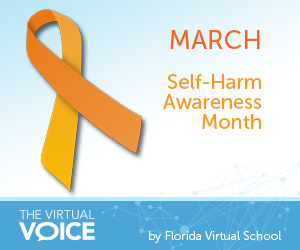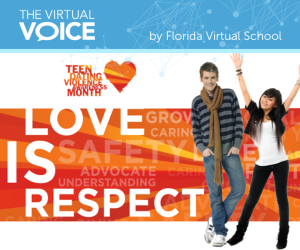FLVS Counselors
National Bullying Prevention Awareness Month
By Amy LaGrasta on October 30th, 2015
 At one point, bullying was simply considered a rite of passage in childhood.
At one point, bullying was simply considered a rite of passage in childhood.
Today, research shows that bullying has a significant impact on one’s education, health, and safety.
Bullying can negatively impact a child’s education. It is estimated that 160,000 children miss school every day due to fear of attack or intimidation by other students. Research shows 15 percent of all school absenteeism is directly related to fears of being bullied at school.
One out of every 10 students who drops out of school does so because of repeated bullying. Continue reading
Suicide Prevention Week
By Guest Blogger on September 8th, 2015
 The International Association for Suicide Prevention (IASP) estimates that there are about 800,000 suicides worldwide each year.
The International Association for Suicide Prevention (IASP) estimates that there are about 800,000 suicides worldwide each year.
That number is probably higher considering that shame and harsh judgment can often accompany news of a suicide, making it easier for family and loved ones to shroud a suicide in other ways. This devastating statistic makes one thing very clear – we need to start talking about it in order to stop it.
September 7-13 marks National Suicide Prevention Week and it is the week surrounding World Suicide Prevention Day on September 10. You may be wondering what you can do. Continue reading
Communication – The Disappearing Art Form
By Guest Blogger on September 2nd, 2014
 Text, Twitter, YouTube, Snapchat…these are but a few of the new and most common ways for today’s generation to communicate. Gone are the days of face-to-face time. Gone are the days of just sitting on the porch and shooting the breeze for hours. Gone are the days of chatting on the phone until late at night and mom coming in and saying “Hey, it’s time to hang up and go to bed.”
Text, Twitter, YouTube, Snapchat…these are but a few of the new and most common ways for today’s generation to communicate. Gone are the days of face-to-face time. Gone are the days of just sitting on the porch and shooting the breeze for hours. Gone are the days of chatting on the phone until late at night and mom coming in and saying “Hey, it’s time to hang up and go to bed.”
Today’s teens spend their hours not speaking with each other, but texting, posting videos, and of course, taking selfies. In May 2014, the term “selfie” joined the Merriam-Webster’s Collegiate Dictionary. (“Selfie: An image of oneself taken by oneself using a digital camera especially for posting on social networks.”) It is now a permanent part of the American vocabulary. Today, kids don’t see the need for words, when a selfie can express what life is all about. Continue reading
Make the Choice to Move Forward
By Amy LaGrasta on April 24th, 2014
 Stop and think about your life’s journey so far.
Stop and think about your life’s journey so far.
Some of us are just getting started on school, many are at the beginning of our careers, and others are nearing retirement. The reality for all of us is that every choice we make and action we take has gotten each of us to where we are today. You, and you alone, are responsible for your happiness or unhappiness, success or failure.
Fate and luck are of no consequence. Accepting personal responsibility is the first step to success. It is the only requirement needed to achieve goals. If you say things like, “it’s not my fault” or “life is unfair,” then you have not yet accepted responsibility for your actions.
It is not too late or too hard to change.
Test Anxiety
By Amy LaGrasta on April 9th, 2014
 Anyone can get test anxiety. In fact, it is normal to feel some stress before a test. The anticipation and nerves you feel can actually help you perform at your peak. However, for some people this normal stress is much more intense. Students who worry a lot in general may feel more anxious at test time. Those who worry about getting every answer correct may be even more prone to test stress.
Anyone can get test anxiety. In fact, it is normal to feel some stress before a test. The anticipation and nerves you feel can actually help you perform at your peak. However, for some people this normal stress is much more intense. Students who worry a lot in general may feel more anxious at test time. Those who worry about getting every answer correct may be even more prone to test stress.
Students who eat right, get plenty of rest, and get ample play and exercise time are better equipped to combat test anxiety. These are important factors all the time, but it’s most important to get all three the day before a test.
Practicing these few tips prove to be valuable skills not only when dealing with test anxiety, but in many of life’s situations: Continue reading
Self-Injury Awareness Month
By Amy LaGrasta on March 24th, 2014
 March is Self-Injury Awareness Month.
March is Self-Injury Awareness Month.
Each year, approximately 2 million cases of self-injury are reported annually in the United States. One in five females and one in seven males engage in self-injury. Ninety percent of people who engage in self harm begin during their teenage or pre-adolescent years.[1]
Self-harm can be a way of coping with problems. It may help express feelings that can’t be put into words, serve as a distraction from life, or release emotional pain. Afterwards, one might feel better—but only for a little while. Although self-harm may give temporary relief, it comes with a cost. In the long term, it causes far more problems than it solves. By not learning healthy ways to deal with emotional pain, it increases risk for bigger problems down the line, including major depression, drug and alcohol addiction, and suicide. Continue reading
Teen Dating Violence Awareness Month
By Amy LaGrasta on February 24th, 2014
 Dating violence is defined by the National Center for Victims of Crime as controlling, abusive, and aggressive behavior in a romantic relationship.
Dating violence is defined by the National Center for Victims of Crime as controlling, abusive, and aggressive behavior in a romantic relationship.
It can include verbal, emotional, physical, or sexual abuse. Teen dating violence runs across race, gender, and socio-economic lines. Anyone can be a victim of dating violence.
One in three teens reports knowing a friend or peer who has been hit, punched, kicked, slapped, or physically hurt by his/her dating partner. Both males and females are victims, but boys and girls are abusive in different ways. Girls are more likely to yell, threaten to hurt themselves, pinch, slap, scratch, or kick. Boys injure girls more severely and frequently. Continue reading
